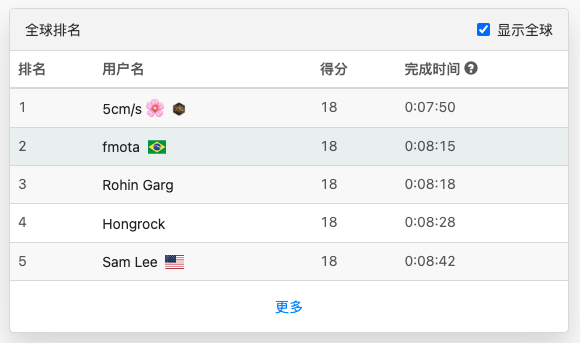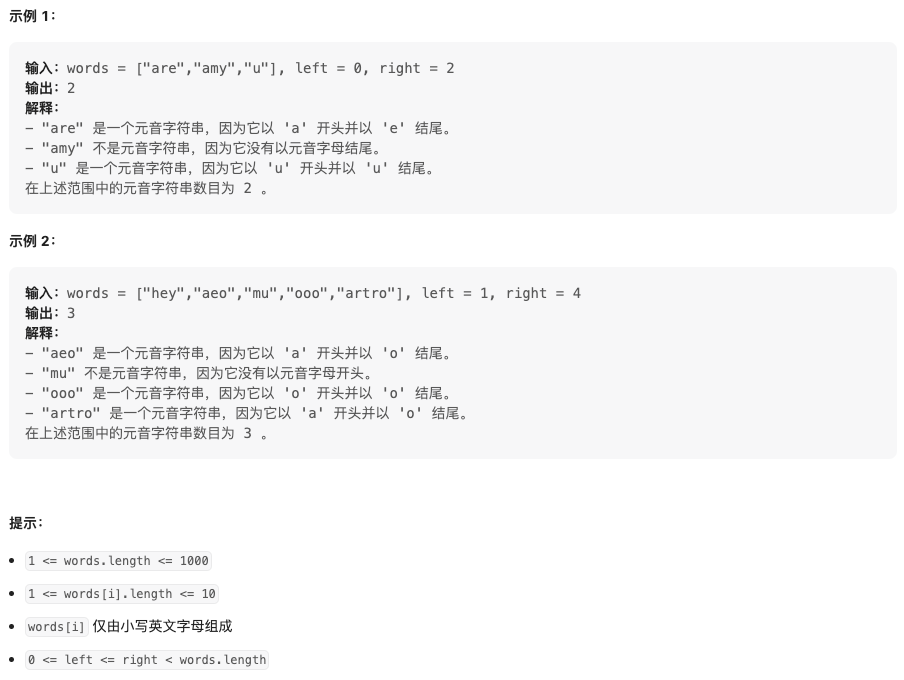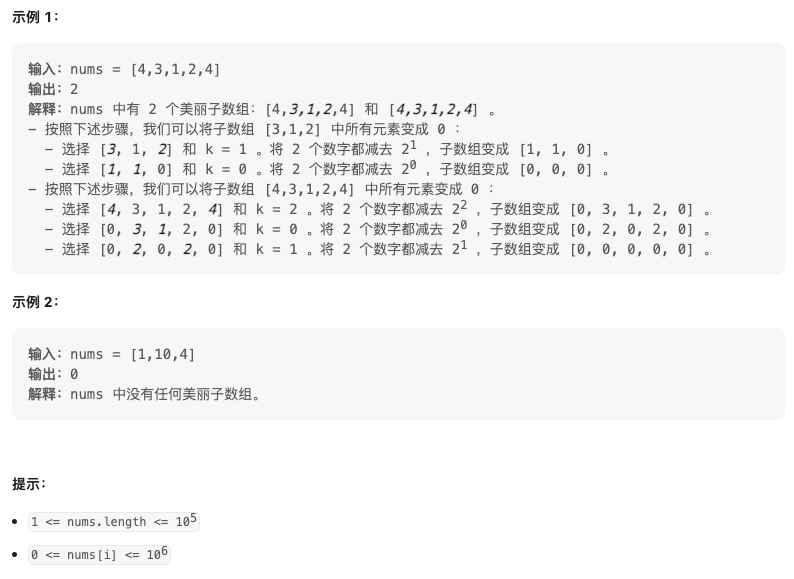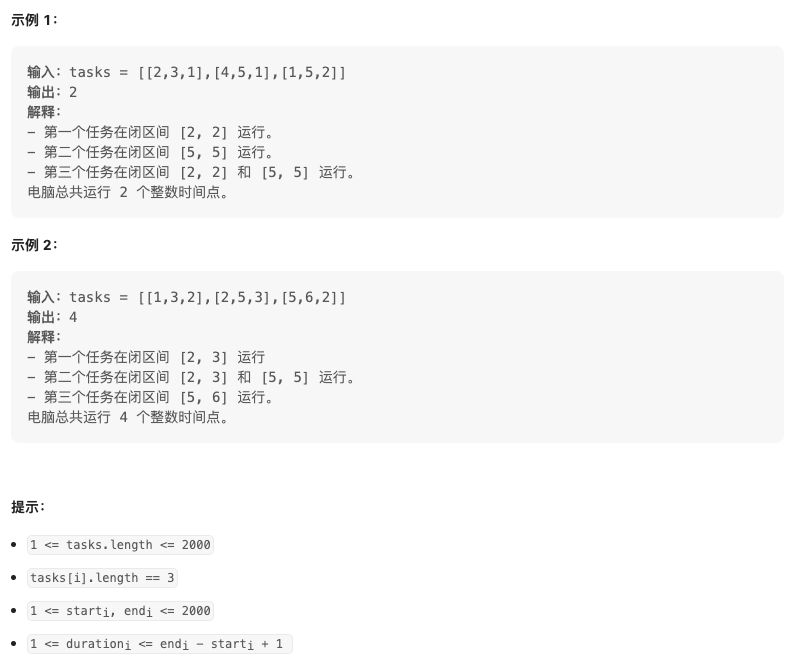本文已收录到 AndroidFamily,技术和职场问题,请关注公众号 [彭旭锐] 提问。
大家好,我是小彭。
今天早上是 LeetCode 第 336 场周赛,你参加了吗?这场周赛整体质量比较高,但是最后一题是老题,CV 能过。但是输入数据范围被降低了,这操作也是没谁了。


https://leetcode.cn/problems/count-the-number-of-vowel-strings-in-range/
给你一个下标从 0 开始的字符串数组 words 和两个整数:left 和 right 。
如果字符串以元音字母开头并以元音字母结尾,那么该字符串就是一个 元音字符串 ,其中元音字母是 'a'、'e'、'i'、'o'、'u' 。
返回 words[i] 是元音字符串的数目,其中 i 在闭区间 [left, right] 内。

简单模拟题。
class Solution {
fun vowelStrings(words: Array<String>, left: Int, right: Int): Int {
val set = hashSetOf('a', 'e', 'i', 'o', 'u')
var count = 0
for (index in left..right) {
val word = words[index]
if (set.contains(word[0]) && set.contains(word[word.length - 1])) count++
}
return count
}
}
复制复杂度分析:
https://leetcode.cn/problems/rearrange-array-to-maximize-prefix-score/
给你一个下标从 0 开始的整数数组 nums 。你可以将 nums 中的元素按 任意顺序 重排(包括给定顺序)。
令 prefix 为一个数组,它包含了 nums 重新排列后的前缀和。换句话说,prefix[i] 是 nums 重新排列后下标从 0 到 i 的元素之和。nums 的 分数 是 prefix 数组中正整数的个数。
返回可以得到的最大分数。

贪心思路:负数会降低前缀和,为了延缓前缀和变小的速度,正权值应该放在尽可能前的位置,负权值放在尽可能后的位置,即对数组降序排序。
class Solution {
fun maxScore(nums: IntArray): Int {
// 3 2 1 0 -1 -3 -3
// 3 5 6 6 5 2 -1
nums.sortDescending()
var preSum = 0L
for (index in nums.indices) {
preSum += nums[index]
if (preSum <= 0L) return index
}
return nums.size
}
}
复制复杂度分析:
https://leetcode.cn/problems/count-the-number-of-beautiful-subarrays/
给你一个下标从 0 开始的整数数组nums 。每次操作中,你可以:
0 <= i, j < nums.length 的不同下标 i 和 j 。k ,满足 nums[i] 和 nums[j] 在二进制下的第 k 位(下标编号从 0 开始)是 1 。nums[i] 和 nums[j] 都减去 2k 。如果一个子数组内执行上述操作若干次后,该子数组可以变成一个全为 0 的数组,那么我们称它是一个 美丽 的子数组。
请你返回数组 nums 中 美丽子数组 的数目。
子数组是一个数组中一段连续 非空 的元素序列。

分析题目操作:当两个数在某一位都是 1 时,可以执行一次消除操作。因此,在满足题目要去的子数组中,所有位上 1 出现的次数要么是 0,要么是大于 0 的偶数,符合异或的性质。于是,我们可以将题目转换为求 “异或值为 0 的子数组” 个数,与以下题目类似:
朴素的解法我们考虑枚举所有子数组:
class Solution {
fun beautifulSubarrays(nums: IntArray): Long {
val n = nums.size
var count = 0L
for (left in 0 until n) {
var xorSum = 0
for (right in left until n) {
xorSum = xorSum xor nums[right]
if (xorSum == 0) count++
}
}
return count
}
}
复制复杂度分析:
“和为 k 的子数组” 有 $O(n)$ 的解法:
class Solution {
fun beautifulSubarrays(nums: IntArray): Long {
val n = nums.size
var count = 0L
// xorSun - index
val xorSumMap = HashMap<Int, Int>().apply {
this[0] = 1
}
var preXorSum = 0
for (num in nums) {
preXorSum = preXorSum xor num
if (xorSumMap.containsKey(preXorSum)) {
count += xorSumMap[preXorSum]!!
}
xorSumMap[preXorSum] = xorSumMap.getOrDefault(preXorSum, 0) + 1
}
return count
}
}
复制复杂度分析:
https://leetcode.cn/problems/minimum-time-to-complete-all-tasks/
你有一台电脑,它可以 同时 运行无数个任务。给你一个二维整数数组 tasks ,其中 tasks[i] = [starti, endi, durationi] 表示第 i 个任务需要在 闭区间 时间段 [starti, endi] 内运行 durationi 个整数时间点(但不需要连续)。
当电脑需要运行任务时,你可以打开电脑,如果空闲时,你可以将电脑关闭。
请你返回完成所有任务的情况下,电脑最少需要运行多少秒。

这道题其实是 LCP 原题:LCP 32. 批量处理任务
区间任务问题一般有按照 “开始时间” 排序或 “结束时间” 排序两种排序方法:
另外,由于任务的开机时间允许不连续,所以我们需要用一个额外的数组存储开机时间。在处理每个任务时,我们先讲已开始时间去掉,再将剩下的时间安排在尽可能晚的时间。
class Solution {
fun findMinimumTime(tasks: Array<IntArray>): Int {
// 按照结束时间排序
Arrays.sort(tasks) { e1, e2 ->
e1[1] - e2[1]
}
val used = BooleanArray(2001)
var time = 0
for (task in tasks) {
var count = task[2]
// 消除已开机时间
for (index in task[0]..task[1]) {
if (used[index]) count--
}
if (count <= 0) continue
time += count
// 推迟最晚开机时间
for (index in task[1] downTo task[0]) {
if (used[index]) continue
used[index] = true
if (--count == 0) break
}
}
return time
}
}
复制复杂度分析:
回顾题解一中的 2个关键操作:
因此,我们发现题目可能存在线段树、树状数组之类优化手段:类似的区间求和问题,我们先回顾一下解决方案:
这道题涉及 “区间更新” 和 “区间求和”,所以属于线段树的覆盖范围。相对于在函数中重复传递节点所代表的区间范围(例如 update(i: int, l: int, r: int, L: int, R: int)),使用 Node 节点记录更为方便。
class Solution {
fun findMinimumTime(tasks: Array<IntArray>): Int {
// 按照结束时间排序
Arrays.sort(tasks) { e1, e2 ->
e1[1] - e2[1]
}
// 线段树
val tree = SegmentTree(2001)
for (task in tasks) {
// 消除已开机时间
val count = task[2] - tree.query(task[0], task[1])
if (count <= 0) continue
// 推迟最晚开机时间
tree.update(task[0], task[1], count)
}
// 根节点即为所有开机时间
return tree.query(1, 2000)
}
private class SegmentTree(private val n: Int) {
// 线段树节点(区间范围与区间值)
private class Node(val left: Int, val right: Int, var value: Int)
// 线段树数组
private val tree = Array<Node?>(n * 4) { null } as Array<Node>
// 左子节点索引
private val Int.left get() = 2 * this + 1
// 右子节点索引
private val Int.right get() = 2 * this + 2
init {
// 建树
buildNode(0, 0, n - 1)
}
private fun buildNode(index: Int, left: Int, right: Int) {
// 叶子节点
if (left == right) {
tree[index] = Node(left, right, 0)
return
}
val mid = (left + right) ushr 1
// 构建左子节点
buildNode(index.left, left, mid)
// 构建右子节点
buildNode(index.right, mid + 1, right)
// 合并左右子节点
tree[index] = Node(left, right, tree[index.left].value + tree[index.right].value)
}
// 开机(推迟到最晚时间)
fun update(left: Int, right: Int, count: Int) {
update(0, left, right, count)
}
// return:有效修改个数
private fun update(index: Int, left: Int, right: Int, count: Int): Int {
// 1、当前节点不处于区间内
if (tree[index].left > right || tree[index].right < left) return 0
// 2、叶子结点
if (tree[index].left == tree[index].right) {
// 开机
if (0 == tree[index].value) {
tree[index].value = 1
return 1
} else {
return 0
}
}
// 3、更新右子树(贪心思路:推迟开机)
var realUpdate = update(index.right, left, right, count)
if (count - realUpdate > 0) {
// 4、更新左子树
realUpdate += update(index.left, left, right, count - realUpdate)
}
// 5、合并左右子节点
tree[index].value = tree[index.left].value + tree[index.right].value
return realUpdate
}
// 查询
fun query(left: Int, right: Int): Int {
return query(0, left, right)
}
private fun query(index: Int, left: Int, right: Int): Int {
// 1、当前节点不处于区间范围内
if (tree[index].left > right || tree[index].right < left) return 0
// 2、当前节点完全处于区间范围内
if (tree[index].left >= left && tree[index].right <= right) return tree[index].value
// 3、合并左右子节点
return query(index.left, left, right) + query(index.right, left, right)
}
}
}
复制复杂度分析:
朴素线段树的性能瓶颈在于:区间更新需要改动从根节点到叶子节点中所有与目标区间有交集的节点,因此单次区间更新操作的时间复杂度是 $O(n)$。
懒更新线段树的核心思想是:当一个节点代表的区间完全包含于目标区间内时,我们没有必要继续向下递归更新,而是在当前节点上标记 Lazy Tag 。只有将来更新该节点的某个子区间时,才会将懒更新 pushdown 到子区间。
class Solution {
fun findMinimumTime(tasks: Array<IntArray>): Int {
// 按照结束时间排序
Arrays.sort(tasks) { e1, e2 ->
e1[1] - e2[1]
}
// 线段树
val tree = SegmentTree(2001)
for (task in tasks) {
// 消除已开机时间
val count = task[2] - tree.query(task[0], task[1])
if (count <= 0) continue
// 推迟最晚开机时间
tree.update(task[0], task[1], count)
}
// 根节点即为所有开机时间
return tree.query(1, 2000)
}
private class SegmentTree(private val n: Int) {
// 线段树节点(区间范围与区间值)
private class Node(val left: Int, val right: Int, var value: Int, var lazy: Boolean = false)
// 线段树数组
private val tree = Array<Node?>(n * 4) { null } as Array<Node>
// 左子节点索引
private val Int.left get() = 2 * this + 1
// 右子节点索引
private val Int.right get() = 2 * this + 2
init {
// 建树
buildNode(0, 0, n - 1)
}
private fun buildNode(index: Int, left: Int, right: Int) {
// 叶子节点
if (left == right) {
tree[index] = Node(left, right, 0)
return
}
val mid = (left + right) ushr 1
// 构建左子节点
buildNode(index.left, left, mid)
// 构建右子节点
buildNode(index.right, mid + 1, right)
// 合并左右子节点
tree[index] = Node(left, right, tree[index.left].value + tree[index.right].value)
}
// 开机(推迟到最晚时间)
fun update(left: Int, right: Int, count: Int) {
update(0, left, right, count)
}
// return:有效修改个数
private fun update(index: Int, left: Int, right: Int, count: Int): Int {
// 1、当前节点不处于区间内
if (tree[index].left > right || tree[index].right < left) return 0
val size = tree[index].right - tree[index].left + 1
val unUsedSize = size - tree[index].value
if (unUsedSize == 0) return 0 // 整个区间已开机
// 2、当前节点完全处于区间范围之内
if (tree[index].left >= left && tree[index].right <= right && unUsedSize <= count) {
// 整个区间可以改为开机
lazyUpdate(index)
return unUsedSize
}
// pushdown
if (tree[index].lazy) {
lazyUpdate(index.left)
lazyUpdate(index.right)
tree[index].lazy = false
}
// 3、更新右子树(贪心思路:推迟开机)
var realUpdate = update(index.right, left, right, count)
if (count - realUpdate > 0) {
// 4、更新左子树
realUpdate += update(index.left, left, right, count - realUpdate)
}
// 5、合并左右子节点
tree[index].value = tree[index.left].value + tree[index.right].value
return realUpdate
}
private fun lazyUpdate(index: Int) {
tree[index].value = tree[index].right - tree[index].left + 1
tree[index].lazy = true
}
// 查询
fun query(left: Int, right: Int): Int {
return query(0, left, right)
}
private fun query(index: Int, left: Int, right: Int): Int {
// 1、当前节点不处于区间范围内
if (tree[index].left > right || tree[index].right < left) return 0
// 2、当前节点完全处于区间范围内
if (tree[index].left >= left && tree[index].right <= right) return tree[index].value
// pushdown
if (tree[index].lazy) {
lazyUpdate(index.left)
lazyUpdate(index.right)
tree[index].lazy = false
}
// 3、合并左右子节点
return query(index.left, left, right) + query(index.right, left, right)
}
}
}
复制复杂度分析: